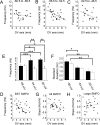Frequency of subthreshold oscillations at different membrane potential voltages in neurons at different anatomical positions on the dorsoventral axis in the rat medial entorhinal cortex
- PMID: 21880929
- PMCID: PMC3177240
- DOI: 10.1523/JNEUROSCI.1654-11.2011
Frequency of subthreshold oscillations at different membrane potential voltages in neurons at different anatomical positions on the dorsoventral axis in the rat medial entorhinal cortex
Abstract
Neurons from layer II of the medial entorhinal cortex show subthreshold membrane potential oscillations (SMPOs) which could contribute to theta-rhythm generation in the entorhinal cortex and to generation of grid cell firing patterns. However, it is unclear whether single neurons have a fixed unique oscillation frequency or whether their frequency varies depending on the mean membrane potential in a cell. We therefore examined the frequency of SMPOs at different membrane potentials in layer II stellate-like cells of the rat medial entorhinal cortex in vitro. Using whole-cell patch recordings, we found that the fluctuations in membrane potential show a broad band of low power frequencies near resting potential that transition to more narrowband oscillation frequencies with depolarization. The transition from broadband to narrowband frequencies depends on the location of the neuron along the dorsoventral axis in the entorhinal cortex, with dorsal neurons transitioning to higher-frequency oscillations relative to ventral neurons transitioning to lower-frequency oscillations. Once SMPOs showed a narrowband frequency, systematic frequency changes were not observed with further depolarization. Using a Hodgkin-Huxley-style model of membrane currents, we show that differences in the influence of depolarization on the frequency of SMPOs at different dorsal to ventral positions could arise from differences in the properties of the h current. The properties of frequency changes in this data are important for evaluating models of the generation of grid cell firing fields with different spacings along the dorsal-to-ventral axis of medial entorhinal cortex.
Figures








Similar articles
-
Voltage dependence of subthreshold resonance frequency in layer II of medial entorhinal cortex.Hippocampus. 2012 Aug;22(8):1733-49. doi: 10.1002/hipo.22008. Epub 2012 Feb 27. Hippocampus. 2012. PMID: 22368047 Free PMC article.
-
Temporal frequency of subthreshold oscillations scales with entorhinal grid cell field spacing.Science. 2007 Mar 23;315(5819):1719-22. doi: 10.1126/science.1139207. Science. 2007. PMID: 17379810 Free PMC article.
-
Time constants of h current in layer ii stellate cells differ along the dorsal to ventral axis of medial entorhinal cortex.J Neurosci. 2008 Sep 17;28(38):9414-25. doi: 10.1523/JNEUROSCI.3196-08.2008. J Neurosci. 2008. PMID: 18799674 Free PMC article.
-
How to build a grid cell.Philos Trans R Soc Lond B Biol Sci. 2013 Dec 23;369(1635):20120520. doi: 10.1098/rstb.2012.0520. Print 2014 Feb 5. Philos Trans R Soc Lond B Biol Sci. 2013. PMID: 24366132 Free PMC article. Review.
-
An oscillatory interference model of grid cell firing.Hippocampus. 2007;17(9):801-12. doi: 10.1002/hipo.20327. Hippocampus. 2007. PMID: 17598147 Free PMC article. Review.
Cited by
-
Cholinergic modulation of the CAN current may adjust neural dynamics for active memory maintenance, spatial navigation and time-compressed replay.Front Neural Circuits. 2012 Mar 15;6:10. doi: 10.3389/fncir.2012.00010. eCollection 2012. Front Neural Circuits. 2012. PMID: 22435051 Free PMC article.
-
Imbalanced Subthreshold Currents Following Sepsis and Chemotherapy: A Shared Mechanism Offering a New Therapeutic Target?Neuroscientist. 2022 Apr;28(2):103-120. doi: 10.1177/1073858420981866. Epub 2020 Dec 21. Neuroscientist. 2022. PMID: 33345706 Free PMC article.
-
Heterogeneous stochastic bifurcations explain intrinsic oscillatory patterns in entorhinal cortical stellate cells.Proc Natl Acad Sci U S A. 2022 Dec 27;119(52):e2202962119. doi: 10.1073/pnas.2202962119. Epub 2022 Dec 19. Proc Natl Acad Sci U S A. 2022. PMID: 36534811 Free PMC article.
-
Coordinated learning of grid cell and place cell spatial and temporal properties: multiple scales, attention and oscillations.Philos Trans R Soc Lond B Biol Sci. 2013 Dec 23;369(1635):20120524. doi: 10.1098/rstb.2012.0524. Print 2014 Feb 5. Philos Trans R Soc Lond B Biol Sci. 2013. PMID: 24366136 Free PMC article.
-
Spontaneous excitation patterns computed for axons with injury-like impairments of sodium channels and Na/K pumps.PLoS Comput Biol. 2012;8(9):e1002664. doi: 10.1371/journal.pcbi.1002664. Epub 2012 Sep 13. PLoS Comput Biol. 2012. PMID: 23028273 Free PMC article.
References
-
- Acker CD, Kopell N, White JA. Synchronization of strongly coupled excitatory neurons: relating network behavior to biophysics. J Comput Neurosci. 2003;15:71–90. - PubMed
-
- Alonso A, Klink R. Differential electroresponsiveness of stellate and pyramidal-like cells of medial entorhinal cortex layer II. J Neurophysiol. 1993;70:128–143. - PubMed
-
- Alonso A, Llinas RR. Subthreshold Na-dependent theta-like rhythmicity in stellate cells of entorhinal cortex layer II. Nature. 1989;342:175–177. - PubMed
-
- Barry C, Hayman R, Burgess N, Jeffery KJ. Experience-dependent rescaling of entorhinal grids. Nat Neurosci. 2007;10:682–684. - PubMed
Publication types
MeSH terms
Grants and funding
LinkOut - more resources
Full Text Sources
